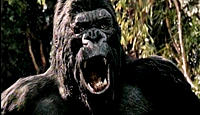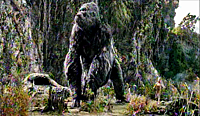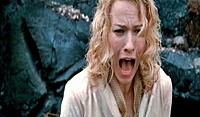The Passion of the Kong
How to Turn a Classic into a Masterpiece
An Appreciation by Barry M. Lamont
Kong
In a lukewarm review of the 1976 remake, a critic - it may have been Pauline Kael in The New Yorker - complained about the portrayal of Kong: in 1933 Kong was an enigma, unpredictable; you didn't know what he was thinking, whether he was going to do something helpful or something destructive. In 1976, there was no such suspense; it was clear from the beginning that Kong was "one of nature's noblemen".
The observation is legitimate; the criticism is not. First, and most obviously, virtually everyone in the theater in 1976 knew the story of King Kong before they even sat down, so it is not clear what suspense there was to spoil. This may be why the filmmakers changed not only the details of the story, but its tone.
More importantly, character should arise from the nature of the story (or vice versa), not the preconceptions of critics. The 1933 original was an action/adventure film; an unpredictable Kong heightened the tension. The 1976 remake, by contrast, is an ironic look at corporate image-making, personal ambition, and man's arrogance towards nature; the 1933 Kong would have undercut the point of the film, made it less effective, by suggesting that maybe man's domination of nature was a good thing.
In the end, however, both the 1933 and the 1976 Kongs are icons or forces, not individuals. Peter Jackson envisioned King Kong as a four-character drama - Kong, Ann Darrow, Jack Driscoll, and Carl Denham, with several supporting characters - so it was essential that Kong actually have a personality. Screenwriters Fran Walsh, Philippa Boyens, and Peter Jackson himself; Andy Serkis' research and acting skills; Jackson's direction; and the wizards at Weta, all made this possible.
[NOTE: From here on out, it becomes increasingly difficult to make my points without referring to specific scenes in the film. I have tried to keep the descriptions somewhat vague, but if you are highly allergic to plot spoilers, I suggest you watch the movie before reading any further.]
Kong's personality, in fact, is that of a child - another unexpected choice, given his size and strength, but a very effective choice for the story. When we first see Kong with Ann, he is out of control, "acting out" what we later understand to be pain and loneliness. When Ann fights back, his attitude changes abruptly - he focuses on her, wary and mistrustful, but now interested. When Ann seeks to defuse his anger by drawing on her own professional background, we discover to our surprise that Kong has a sense of humor - a child's sense, an enjoyment of physical comedy. (Note that in Peter Jackson's film, Ann is much more than a helpless, passive victim, and as a result, the emotional bond that develops between them is much deeper and more complex, and pulls the audience much deeper into the story.) When Ann puts a halt to their play, Kong has a classic and very recognizable temper tantrum, smashing everything in sight - but never laying a hand on Ann. He sulks off, but it is too late; he has already let himself get attached to her. After he rescues her from the T Rex's - and the scene builds perfectly to his arrival - Kong pretends that he doesn't really care about her; Jackson is slyly echoing and commenting on Bruce Baxter's attitude ("When a man likes a woman, he must ignore her").
When Kong takes Ann up to his sanctuary, we see for the first time how hurt and alone he is, in a world where everyone in his family is gone and everything else is trying to eat him; Ann tries to cheer him up, but he is a million miles away. His need for her companionship suddenly makes perfect sense; how long has it been since anyone was kind to him? Not looking at her, Kong gently opens his palm, obviously hoping that she will choose to step into it, but afraid to admit how much he needs her. Later, when he is attacked by ugly flying creatures - both a foreshadowing and a comment on his final battle on the Empire State Building - and Ann makes her escape with Jack, Kong's frustration, clearly distinct from simple anger, is palpable. With reckless determination he chases after her, crashing through the ancient wall (for the first time ever?) and, ultimately, into Denham's trap. There, for the first time, his mask of pride slips away, and when we finally see a frightened child reach out desperately for his friend, the effect is devastating.
None of these character notes are found in the 1933 version. Most of these scenes do not even exist in that film; those that do are played much more generically, for spectacle rather than character. It is also worth pointing out that Kong's personality is conveyed solely through facial expression, gesture, and body language, since Kong obviously can not speak; in effect, this may be one of the greatest "silent screen" performances ever put on film.
I do want to mention one other scene which exemplifies Peter Jackson's skill as a filmmaker. In the 1933 original, we don't see or hear Kong until he arrives to take Ann from the altar; there are suggestions and warnings, and the crew wonders why Denham wants to film Ann screaming in horror, but none of these scenes lead anywhere. Presumably Cooper and Schoedsack, King Kong's creators, felt that the film would build greater suspense that way; perhaps it does, but the trade-off is a lack of momentum. Peter Jackson's handling of Kong's "entrance", which he actually revised and improved while filming, is much more imaginative. The shore party does not come upon a native "bride of Kong" ritual in progress; instead they move directly into a tense and dangerous confrontation. With our attention completely focused on this crisis, the sudden, perfectly timed introduction of Kong is a startling, unexpected turn. (There is an occurrence very much like this in Heart of Darkness.) Furthermore, the scene pivots on that revelation but maintains its momentum, and everything that happens in the remainder of the film is a direct consequence of that moment. It is simply better storytelling.
The observation is legitimate; the criticism is not. First, and most obviously, virtually everyone in the theater in 1976 knew the story of King Kong before they even sat down, so it is not clear what suspense there was to spoil. This may be why the filmmakers changed not only the details of the story, but its tone.
More importantly, character should arise from the nature of the story (or vice versa), not the preconceptions of critics. The 1933 original was an action/adventure film; an unpredictable Kong heightened the tension. The 1976 remake, by contrast, is an ironic look at corporate image-making, personal ambition, and man's arrogance towards nature; the 1933 Kong would have undercut the point of the film, made it less effective, by suggesting that maybe man's domination of nature was a good thing.
In the end, however, both the 1933 and the 1976 Kongs are icons or forces, not individuals. Peter Jackson envisioned King Kong as a four-character drama - Kong, Ann Darrow, Jack Driscoll, and Carl Denham, with several supporting characters - so it was essential that Kong actually have a personality. Screenwriters Fran Walsh, Philippa Boyens, and Peter Jackson himself; Andy Serkis' research and acting skills; Jackson's direction; and the wizards at Weta, all made this possible.
[NOTE: From here on out, it becomes increasingly difficult to make my points without referring to specific scenes in the film. I have tried to keep the descriptions somewhat vague, but if you are highly allergic to plot spoilers, I suggest you watch the movie before reading any further.]
Kong's personality, in fact, is that of a child - another unexpected choice, given his size and strength, but a very effective choice for the story. When we first see Kong with Ann, he is out of control, "acting out" what we later understand to be pain and loneliness. When Ann fights back, his attitude changes abruptly - he focuses on her, wary and mistrustful, but now interested. When Ann seeks to defuse his anger by drawing on her own professional background, we discover to our surprise that Kong has a sense of humor - a child's sense, an enjoyment of physical comedy. (Note that in Peter Jackson's film, Ann is much more than a helpless, passive victim, and as a result, the emotional bond that develops between them is much deeper and more complex, and pulls the audience much deeper into the story.) When Ann puts a halt to their play, Kong has a classic and very recognizable temper tantrum, smashing everything in sight - but never laying a hand on Ann. He sulks off, but it is too late; he has already let himself get attached to her. After he rescues her from the T Rex's - and the scene builds perfectly to his arrival - Kong pretends that he doesn't really care about her; Jackson is slyly echoing and commenting on Bruce Baxter's attitude ("When a man likes a woman, he must ignore her").
When Kong takes Ann up to his sanctuary, we see for the first time how hurt and alone he is, in a world where everyone in his family is gone and everything else is trying to eat him; Ann tries to cheer him up, but he is a million miles away. His need for her companionship suddenly makes perfect sense; how long has it been since anyone was kind to him? Not looking at her, Kong gently opens his palm, obviously hoping that she will choose to step into it, but afraid to admit how much he needs her. Later, when he is attacked by ugly flying creatures - both a foreshadowing and a comment on his final battle on the Empire State Building - and Ann makes her escape with Jack, Kong's frustration, clearly distinct from simple anger, is palpable. With reckless determination he chases after her, crashing through the ancient wall (for the first time ever?) and, ultimately, into Denham's trap. There, for the first time, his mask of pride slips away, and when we finally see a frightened child reach out desperately for his friend, the effect is devastating.
None of these character notes are found in the 1933 version. Most of these scenes do not even exist in that film; those that do are played much more generically, for spectacle rather than character. It is also worth pointing out that Kong's personality is conveyed solely through facial expression, gesture, and body language, since Kong obviously can not speak; in effect, this may be one of the greatest "silent screen" performances ever put on film.
I do want to mention one other scene which exemplifies Peter Jackson's skill as a filmmaker. In the 1933 original, we don't see or hear Kong until he arrives to take Ann from the altar; there are suggestions and warnings, and the crew wonders why Denham wants to film Ann screaming in horror, but none of these scenes lead anywhere. Presumably Cooper and Schoedsack, King Kong's creators, felt that the film would build greater suspense that way; perhaps it does, but the trade-off is a lack of momentum. Peter Jackson's handling of Kong's "entrance", which he actually revised and improved while filming, is much more imaginative. The shore party does not come upon a native "bride of Kong" ritual in progress; instead they move directly into a tense and dangerous confrontation. With our attention completely focused on this crisis, the sudden, perfectly timed introduction of Kong is a startling, unexpected turn. (There is an occurrence very much like this in Heart of Darkness.) Furthermore, the scene pivots on that revelation but maintains its momentum, and everything that happens in the remainder of the film is a direct consequence of that moment. It is simply better storytelling.





